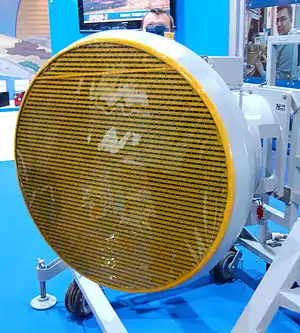Irbis-E
Irbis-E (Snow Leopard) is a Russian multi-mode, hybrid passive electronically scanned array radar system developed by Tikhomirov NIIP for the Su-35 multi-purpose fighter aircraft. NIIP developed the Irbis-E radar from the Bars radar system used on Sukoi SU-30MK aircraft.
| Irbis-E radar | |
|---|---|
 | |
| Role | X band Hybrid Passive electronically scanned array |
| National origin | Russia |
| Manufacturer | Tikhomirov NIIP |
| Designer | Tikhomirov NIIP |
| Status | Operational |
| Primary user | Russian Air Force |
| Developed from | Bars radar |
| Developed into | Byelka |
Design
Irbis-E development started in 2004 and the first radar prototype entered flight tests on board an Su-30M2 aircraft acting as a test bed in early 2007. The resulting radar system provides air-to-air, air-to-sea and air-to-ground (ground mapping, Doppler beam sharpening and Synthetic Aperture Radar modes) modes with improved performance in intense clutter (radar) environments compared to its predecessor, the Bars system. In addition, Irbis has been designed to detect low and super-low observable/stealth airborne threats.
This is an X band multi-role radar with a passive phased antenna array (PAA) mounted on a two-step hydraulic drive unit (in azimuth and roll). The antenna device scans by an electronically controlled beam in azimuth and angle of elevation in sectors not smaller than 60°. The two-step electro-hydraulic drive unit additionally turns the antenna by mechanic means to 60° in azimuth and 120° in roll. Thus, in using the electronic control and mechanical additional turn of the antenna, the maximum deflection angle of the beam grows to 120°.[1] The Irbis-E is a direct evolution of the BARS design, but significantly more powerful. While the hybrid phased array antenna is retained, the noise figure is slightly worse at 3.5 dB, but the receiver has four rather than three discrete channels. The biggest change is in the EGSP-27 transmitter, where the single 7-kilowatt peak power rated Chelnok TWT is replaced with a pair of 10-kilowatt peak power rated Chelnok tubes, ganged to provide a total peak power rating of 20 kilowatts. The radar is cited at an average power rating of 5 kilowatts, with 2 kilowatts CW rating for illumination. NIIP claim twice the bandwidth and improved frequency agility over the BARS, and better ECCM capability. The Irbis-E has new Solo-35.01 digital signal processor hardware and Solo-35.02 data processor, but retains receiver hardware, the master oscillator and exciter of the BARS. A prototype has been in flight test since late 2005.[2]
Operational features
Irbis-E can detect and track up to 30 airborne targets at one time at ranges near 350~400 kilometers, and attack up to 8. In air-to-surface mode the Irbis-E provides mapping allowing to attack four surface targets with precision-guided weapons while scanning the horizon searching for airborne threats that can be engaged using active radar homing missiles.
It can detect a target with radar cross-section (RCS) 3m2 at up to 400 km, (towards each other, in an area of 100 square degrees)[3][4] while a target with RCS 0.01m2 at up to 90 km.[5](dead link)
It is one of the most powerful PESA radar used in an operational aircraft.[6]
References
- "sukhoi 35s radar". sukhoi company. Archived from the original on 30 March 2016. Retrieved 22 April 2013.
- Kopp, Carlo (3 April 2008). "Flanker Radars in Beyond Visual Range Air Combat". ausairpower.net. Archived from the original on 13 April 2014. Retrieved 12 April 2014.
- "Радиолокационная система управления «ИРБИС-Э» для истребителя Су-35" [Radar control system "IRBIS-E" for the Su-35 fighter] (in Russian). Archived from the original on 2011-12-30.
- "Niip official". tikhominov niip. Retrieved 22 April 2013.
- http://www.niip.ru/downloads/public_art/2006/2006_2.pdf%5B%5D
- http://www.ausairpower.net/APA-Flanker-Radars.html
"RLSU "Irbis-E"". Archived from the original on 2020-03-03.
